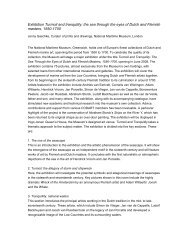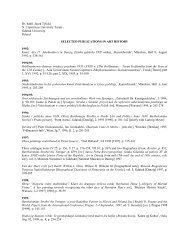courant 7 - CODART
courant 7 - CODART
courant 7 - CODART
You also want an ePaper? Increase the reach of your titles
YUMPU automatically turns print PDFs into web optimized ePapers that Google loves.
11 codart Courant 7/December 2003<br />
and pasted color images of the panels into a<br />
hypothetical reconstruction of the polyptych,<br />
known as the Miraflores Altar. At the<br />
exhibition he was able to display the<br />
reconstruction of all panels but one.<br />
Only the fifth panel, The preaching of John<br />
the Baptist, was illustrated in black-and-white.<br />
The location was given as formerly Hungary,<br />
private collection, but if truth be told, Borchert<br />
had no idea where the painting was. He only<br />
knew as much about it as he did thanks to the<br />
work of another codartmember, Susanne<br />
Urbach of Budapest, who unfortunately was<br />
unable to attend codart zes. In the 1970s,<br />
in the photo collection of her own<br />
Szépmüveszeti Múzeum, she had stumbled<br />
across an old image of the painting, labeled as<br />
in the collection of Arthur Isfkovits, on loan to<br />
the museum of Debrecen. But that was in 1905.<br />
Enquiries in Debrecen revealed that Isfkovitz’s<br />
daughter retrieved the painting, along with<br />
other works that had belonged to her father,<br />
in 1948. In 2001, by which time Urbach and<br />
other researchers had put together a likely<br />
reconstruction of the five-panel polytpych,<br />
Urbach published an article on the Miraflores<br />
Altar in the Jaarboek van het Koninklijk Museum<br />
voor Schone Kunsten in Antwerp, calling on<br />
colleagues to look for the missing panel.<br />
How did Tatjana Bosnyak get to the codart<br />
congress in Amsterdan on 18 March 2003? That<br />
story begins not that long ago, in Bucharest in<br />
May 2001. I was in the city upon the invitation<br />
of the New Europe College. Henk van Os and I<br />
were there as guest lecturers for a week. As it<br />
happened, during that week, a new wing of the<br />
National Museum of Art of Romania was<br />
opened, the wing devoted to the country’s<br />
medieval art. Henk and my wife Loekie and I<br />
were invited to all the events surrounding this<br />
important occasion. The design and<br />
refurbishing of the seven new galleries had<br />
been executed in part by a remarkable Dutch<br />
expat in Romania, the heart surgeon and<br />
building contractor Peter Oostveen, whom I<br />
had met and befriended during codart<br />
vierthe year before. His work on the new<br />
wing was remarkable for its quality, speed and<br />
low price. This was repeated over and over by<br />
the speakers at the official opening, one of<br />
whom was Walter Feilchenfeldt, head of the<br />
International Music and Art Foundation<br />
(Liechtenstein), which had sponsored the job.<br />
His entire speech consisted of the following<br />
remarks: ‘Usually, our foundation does not pay<br />
more than 50 percent of the costs of a project.<br />
However, when we saw the budget for this job<br />
and the specifications, we were so astonished<br />
Reconstruction of the Miraflores Altar, a polyptych by Juan de Flandes, ca. 1500, as published in the catalogue of the<br />
exhibition Jan van Eyck, Early Netherlandish paintings and the south of Europe, 1430-1530, in the Groeningemuseum,<br />
Bruges 2002.<br />
at how much was going to be accomplished for<br />
how little money that we voted to provide it<br />
all. We gave $250,000, which was enough to<br />
completely renovate seven large galleries to a<br />
high international standard. Thank you.’<br />
At the gala dinner in the museum, a guest<br />
he did not know approached Oostveen. ‘Sir,’ he<br />
said, ‘I am the Minister of Culture of<br />
Yugoslavia. You know we also have an art<br />
museum, in Belgrade, which also needs to be<br />
fixed up. Would you like to do the job?’<br />
Oostveen is not a man to turn down an<br />
invitation like that. After his first visit to<br />
Belgrade, he called me to report on his<br />
experiences. ‘They’re passing a special law to<br />
give me executive powers for this job. And it’s<br />
not only the galleries. They also want me to<br />
help them identify the paintings in the<br />
collection and get them shown abroad. What<br />
do I do?’ I knew immediately what he should<br />
do. I gave him the name and telephone<br />
number of Lia Gorter, a codartmember and<br />
partner in our Russian projects, who<br />
specializes in operations of exactly this kind.<br />
I also called Lia and gave her Peter’s number.<br />
They made contact, and in January 2003 Lia<br />
traveled to Belgrade with her trusted associate<br />
Bernard Vermet. There they met Tanja<br />
Bosnyak, who showed them the Netherlandish<br />
holdings of the museum. Working their way<br />
through the paintings, one of the works that<br />
caught their attention was the panel of John<br />
the Baptist. They suggested to Tanja that she<br />
come to the codartcongress and show<br />
slides of her more interesting paintings. By<br />
the time I received her request to speak at<br />
codart zes, I had been prepared for the<br />
approach by Görel Cavalli-Bjorkman, who had<br />
been in Belgrade in late November 2002, and<br />
had mailed me about the collection out of<br />
concern about its condition. The Program<br />
Committee approved a ten-minute<br />
presentation of the Dutch and Flemish<br />
paintings from Belgrade at its meeting of<br />
19 February 2003, where it was decided to<br />
concentrate on relatively unknown<br />
collections.<br />
The rest is (art) history, a history that took<br />
its next turn in September 2003 when Borchert<br />
discussed the new discovery at the bi-annual<br />
congress on underdrawings in early<br />
Netherlandish painting with some colleagues.<br />
There he, Susanne Urbach and Bernard Vermet<br />
were joined by Helene Mund of the Study<br />
Center for the Flemish Primitives, and Livia<br />
Depuydt, head of the painting conservation<br />
department of the Koninklijk Instituut voor<br />
het Kunstpatrimoniun, in a plan to bring the<br />
panel to Brussels for restoration. They expect



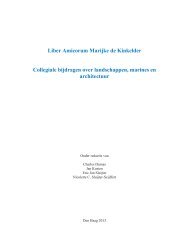
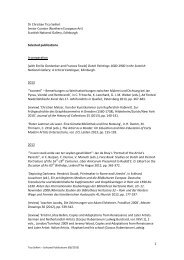

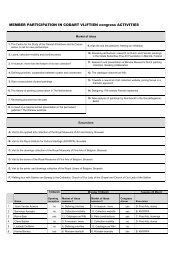

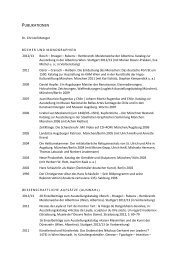

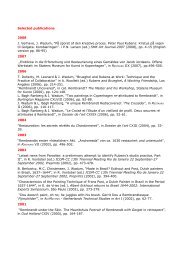
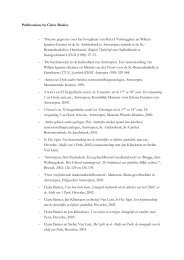
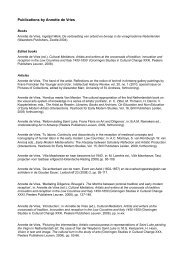
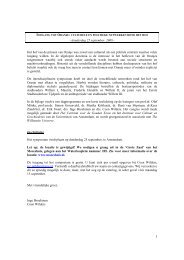
![curriculum [wim] - CODART](https://img.yumpu.com/19451661/1/184x260/curriculum-wim-codart.jpg?quality=85)
![curriculum [wim] - CODART](https://img.yumpu.com/19451660/1/184x260/curriculum-wim-codart.jpg?quality=85)
